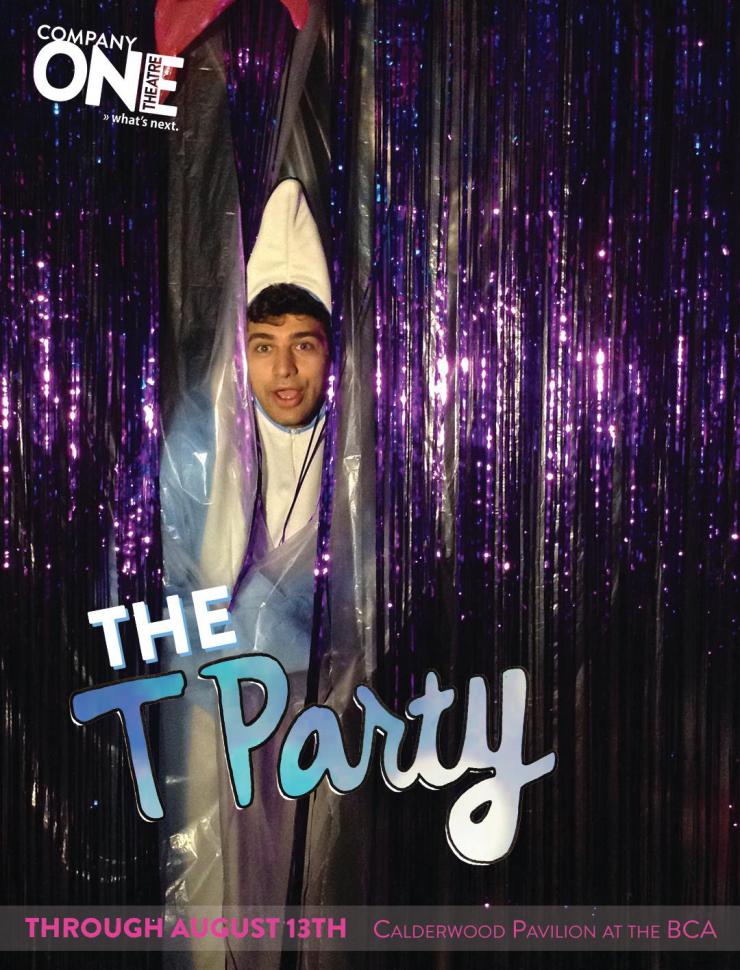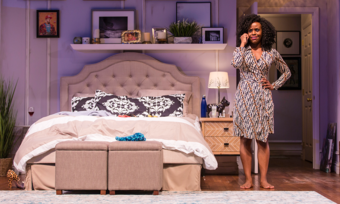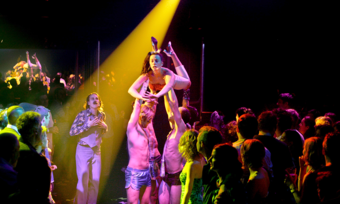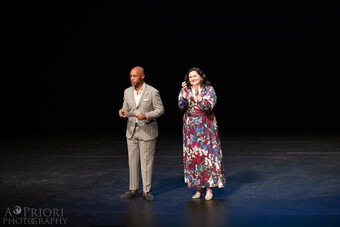Audience Engagement in a Dolphin Costume
Natsu Onoda Power’s The T Party demonstrates the spectrum of gender identity and fluidity through eclectic and form-smashing scenes. In Company One Theatre's production, the first act is set in 1994 at C1 High's prom. Inside the Nancy and Edward Roberts Studio Theatre is an environment begging for audience participation: a dance floor between the two risers of seats facing each other, blaring pop music, a photographer taking portraits, and familiar high school tropes—i.e. the jock, the nerd, and the hippie—all embodied by the show’s cast. These identities are quickly dropped after the prom court is announced.
Upon entering the theatre, most people planted themselves in their assigned seat. With the exception of some high school-aged students that came in large groups, the majority of audiences opted to sit and silently spectate. And I don’t judge them for doing so, dance floors are wildly intimidating. I certainly felt some repressed prom-trauma (prauma) flashing before my eyes. Unless I was with the right person, there’s no way anyone would get me out of my seat. My goal is to be that person.
I am a first generation American who still celebrates my Mexican culture with my family. The biggest thing that isolates me from theatre, though, is that I am a gray asexual. I feel no romantic or sexual feelings of any sort.
As a member of Company One’s Street Team, we work in the intersection of the dramaturgical team, audience engagement, and front of house staff. Usually our work is facilitating conversations pre/post show, and collecting audience surveys. For this show, our task was to slip into a character, and get people to dance so they were out of their seats and interacting with the space. Company One’s style of audience engagement feels revolutionary because it dispatches their entire staff at performances. Marketing Fellows, the Artistic Director, Dramaturgs, and more are all regulars and approachable for audience members.
For my first shift, I dressed in a flamboyant Robert Graham shirt, with red and blue that matched my nametag. I awkwardly went up to audience members, encouraging (almost threatening) them to dance.
Approximate conversation recount #3/10:
Me: Come dance!
Audience Member: No thanks.
Me: It’s fun, it’ll be a good time!
AM: …
Me: We also have a photo booth over there! Check it out.
AM: I’m good.
There were too many of these interactions, sometimes repeated with people who still didn’t want to dance.
I had prauma flashbacks: I was out of my element, trying to have a good time with people I didn’t know. Yes, it was an authentic prom, but I felt as though I was ruining the whimsy and nostalgia this C1 Prom had. I knew there was a better way for me to interact with this audience, maybe changing my tone, or getting more comfortable. There was a certain atmosphere I wanted to blend into so the audience would be game for a series of gender transgressing scenes, songs, and stories.
Halfway through my next shift, someone mentioned the Dolphin costume backstage. Dolphins are C1 High’s mascot, and the focus of one scene (a dance and song/rap adaptation of a scholarly article about Bottlenose Dolphin’s homosexual behaviors). I slipped into the costume and waddled onto the dance floor. The “students” cheered at the entrance of their mascot, Finny. In the costume I felt like I had a place in this space, like I was free to dance wilder and be myself…but sillier. The actors and audience wanted to dance with me, and I instantly put a smile on people’s face; the costume was deeply empowering.
It was how I wish all my clothing affected me.
The dolphin costume didn’t just make it fun for me, but established my relationship with the audience and my job much better than my nametag did.

For my next shift, I immediately requested to be on “Finny” duty. After busting out onto the dance floor, I approached groups of sitting audience members up on the risers. I sensed a bit of fear, the fear I have felt at the theatre when an actor in character is about to make me interact. They anticipated that I was coming to pull them onto the dance floor. Rather than putting on any sort of character, I nonchalantly say, “Hey do you want to come on the dance floor?” I don’t sound like the high school mascot at a pep rally, or a character in the prom’s world, I’m just Travis in a dolphin costume. I followed the lead of the actors who were welcoming and friendly with audiences on the dance floor, as they played high school prom versions of themselves.
Most people decline my invitation, so I encourage them to go have their photo taken, letting them know that they’ll get a printed copy after the show. Even though I may appear to be a part of the show, I’m totally in the audience’s reality, which I think works well. For people who are maybe a bit uncomfortable or unsure how to behave in the atmosphere, I’m a guide, model, or encourager of moving from spectator to engager. I’m acknowledging that, “Yes…I am in a dolphin costume…we are at the theatre…let’s have fun.” A handful of times, audience members or couples rejected all of my invitations, so I lowered my voice and closed the conversation with, “Explore the space, don’t just sit."
A couple of people I asked to dance did get up to boogie. Others were unaware that someone was taking portraits in one corner, or that there was a prom court election, or that there was a













Comments
The article is just the start of the conversation—we want to know what you think about this subject, too! HowlRound is a space for knowledge-sharing, and we welcome spirited, thoughtful, and on-topic dialogue. Find our full comments policy here
Hi Travis. I found it interesting that you felt much more free when dressed up as a dolphin. I've been cosplaying for awhile now and it gives me the same kind of effect as the one you described in your article. When I'm at school, work, or out shopping I feel this stress to kind of conform to society's norms and to blend in. I'm not wearing a mask or a costume I am simply being myself: I am Lily. You feel exposed in a sense. Instead of having a fictional character's personality and action to conform to, you're left to defend for yourself. One of my favorite cosplays that I have done is Princess Peach from the Mario games. When I'm dressed up in that huge pink dress and daunting my princess accessories I don't have this same self conscious and judgmental expectations as I do when I'm dressed in every day clothes. I'm no longer Lily...I am Princess Peach. It's like slipping into a whole other persona where you're free to do what you want and say what you want and not having somebody personally judge you for it. I'm not saying escaping into a fantasy world is the solution for everything but cosplaying is a nice temporary escape from being myself for a day and instead slipping into a character.